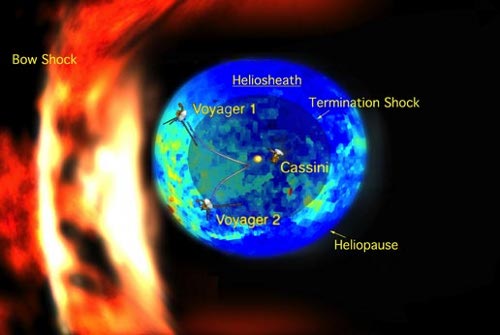One problem with journeys that are beyond today’s technologies is that we forget, in our zeal to get a payload to the target, how little we know about the regions we’ll pass through along the way. It’s amazing how little we know, for example, about the heliosphere around the Solar System, yet any probe pushing into interstellar space will have to cross from the region of space under the Sun’s influence into a zone where the interstellar medium flows around this ‘bubble,’ disturbing the solar wind and creating a secondary bubble, the heliosheath.
We don’t yet have a global view of what spacecraft will encounter in the heliosheath as the solar wind is heated and slowed by these interactions. Only recently have we gotten the Voyagers into these regions, and in any case these doughty vehicles can only produce single-point measurements. But we’ve got the IBEX (Interstellar Boundary Explorer) spacecraft making observations from near Earth, and now we learn that Cassini, our intrepid Saturn orbiter, has also produced excellent data on what happens at system’s edge.
NASA is now offering an interesting animation of the heliosphere and heliosheath, showing the interstellar medium flowing past, with the interstellar magnetic field moving around the bubble of hot, high pressure particles. The findings that produced this animation are intriguing because it was previously thought that the Solar System moved through the interstellar medium in a shape resembling that of a comet. Instead, scientists using Cassini’s Ion and Neutral Camera sensor on its Magnetospheric Imaging Instrument (MIMI) find that the heliosphere is less like a comet and more like a ball moving through smoke, the ‘smoke’ being the interstellar magnetic field.
This JPL news release uses a more vivid turn of phrase: “…the new results suggest our heliosphere more closely resembles a bubble – or a rat – being eaten by a boa constrictor: as the solar system passes through the “belly” of the snake, the ribs, which mimic the local interstellar magnetic field, expand and contract as the rat passes.”

Image: In this illustration, the multicolored (blue and green) bubble represents the new measurements of the emission of particles known as energetic neutral atoms. The energetic neutral atoms were streaming in from the thick boundary known as the heliosheath. The heliosheath is the region between the heliosphere, the region of our sun’s influence, and the interstellar medium, the matter between stars in our galaxy. Areas in red indicate the hottest, most high-pressure regions and purple the coolest, lowest-pressure regions. Credit: NASA/JPL/JHUAPL.
As to the heliosheath itself, the Cassini data indicate it’s somewhere between 40 and 50 AU thick. That’s a remarkable result from a spacecraft that has as its primary mission the investigation of Saturn and its moons. But Cassini’s studies of the energetic electrons and ions trapped in Saturn’s magnetic field, and of the energetic neutral atoms also produced in this environment, have produced a treasure trove of data that includes particles arriving from the outer Solar System.
Usefully, the picture that began to emerge from Cassini squared with what IBEX had already produced, thus deepening our understanding of this outer region. Says MIMI scientist Don Mitchell (JHUAPL):
“I was initially skeptical because the instrument was designed for Saturn’s magnetosphere. But our camera had long exposures of months to years, so we could accumulate and map each particle that streamed through the tiny aperture from the far reaches of the heliosphere. It was luck, but also a lot of hard work.”
The paper is Krimigis et al., “Imaging the Interaction of the Heliosphere with the Interstellar Medium from Saturn with Cassini,” Science, Vol. 326, No. 5955 (13 November 2009), pp. 971-973 (abstract).



Hi Paul;
One of my brothers as well as myself have often muzed on the great work done by the folks at JPL. To think that we have probes assisting with the mapping of the heliosheath. This is almost interstellar space.
I am greatly looking forward to high thrust ion rockets as well as the VASIMR plasma engines’ debue.
One thing seems certain to me. To the extent that the universe will last quite literally forever, or perhaps more broadly the entirety of creation we call the cosmos will last forever, the extension of the arrow of time into the future is utterly unbounded in terms of possibilities.
The Folks at JPL have given all of us space heads and physics and engineering geeks in general, a great collective sense of accomplishment, as well as the same for the many fine citizens of our country and planet Earth who are not typically inclined to focus on the physical sciences and space travel.
Perhaps the next space craft technology including that for manned missions should be referred to as pre-interstellar flight technology to distinguish the technology from interplanetary travel technology.
We seemed to have mastered the process of interplanetary unmanned space flight and now we need to move to interplanetary manned space flight, then to pre-interstellar manned space flight, and then manned space flight to the stars.
JPL will very very likely be greatly instrumental in pre-interstellar flight technology development during the next couple of decades as the Ad Astra Rocket Company developes and refines their rocket motors.
I can envision many bold steps in robotic and manned space exploration coming to fruition over the next 2 or 3 decades. I think we space heads are in for a fun ride.
This is an absolutely amazing mission with unexpected results. The previously undetected bright ribbon of ENA’s in between Voyager 1 and 2 is a testament to the enormity of space! Hopefully with help from Cassini, the IBEX mission can uncover the mystery of the interstellar magnetic field and heliopause interaction.